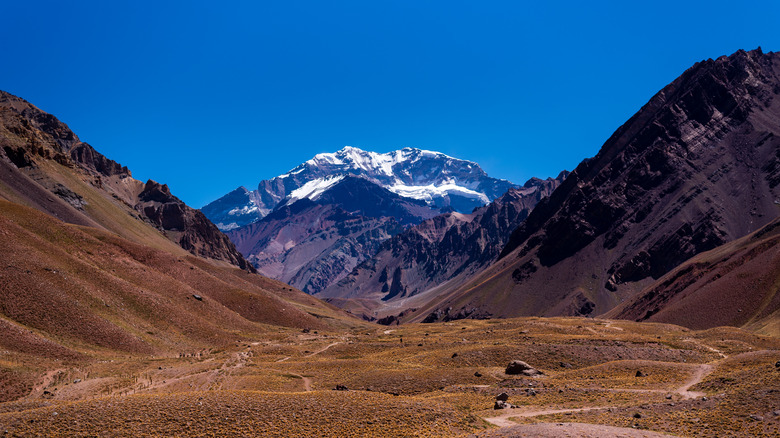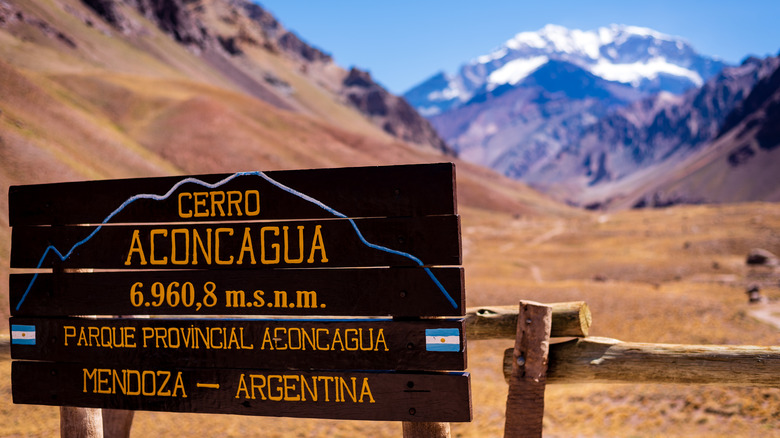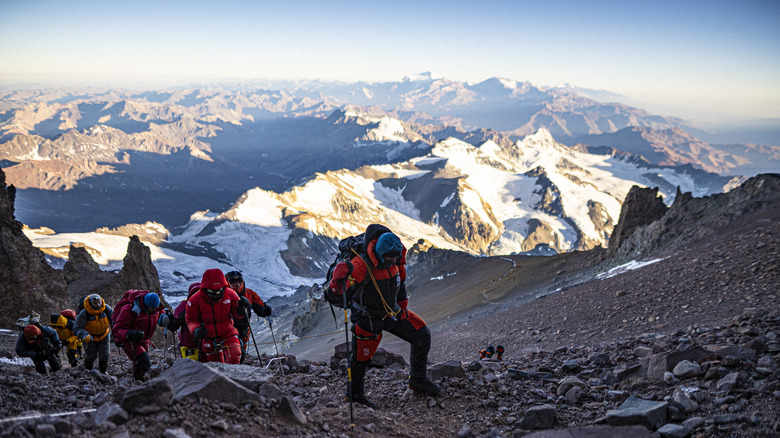Climb The Highest Mountain In The Americas On This Dangerous And Exhilarating Hike
Mount Everest, located in the Himalayas, is the tallest mountain in the world at 29,029 feet. However, outside of the Asian continent, is another tall, record-breaking mountain, that is also — along with Mount Everest — one of the legendary "Seven Summits," or the seven tallest mountains on each of the Earth's continents. In the heart of the Andes mountain range, Mount Aconcagua stands as the tallest peak in the Americas, reaching a gigantic height of 22,828 feet. This is one of many majestic mountains you must see in your lifetime. Located in the Mendoza Province of Argentina, it attracts adventurers and mountaineers from all over the globe, eager to conquer its challenging slopes and experience the thrill of standing atop the highest point in the Western and Southern Hemispheres.
Aconcagua, meaning "stone sentinel" in the Indigenous Quechua language, presents a variety of routes, from relatively straightforward paths (360 Route) to challenging technical climbs (Polish Glacier route). The most popular route, known as the "Normal Route," has no crevasse risk, technical pitches, or other hazards found on similarly high mountains, but still demands physical fitness, acclimatization, and determination. Moreover, even though it's nearly 23,000 feet tall, Aconcagua doesn't see much, if any snow. Because of these favorable conditions compared to the other Seven Summits, the peak attracts around 4,000 climbers every year, 80% of whom are part of a guided expedition. However, despite its status as a "starter mountain," Aconcagua is also nicknamed the "Mountain of Death" — every year, an average of three climbers don't make it out alive.
From Mendoza to Aconcagua base camp
The journey to Aconcagua begins in the city of Mendoza, a must-visit destination where you can wine and dine (and maybe learn to dance the tango before your ascent). From Mendoza, climbers will head to the permit office to obtain the essential permits, costing $1,300 for an independent climb or $800 for an assisted/serviced climb. Then, you'd travel to the village of Los Penitentes, where final preparations and gear checks are made. The trek to base camp, Plaza de Mulas, is an adventure in itself which takes about three to four days.
@inka.expediciones 🏔️ Conquering Aconcagua: The Journey to the Top! This video gives you a sneak peek into my incredible journey along the Normal Route. From park entrance to the summit – the ultimate high-altitude adventure! Let's reach that summit together! Follownus for more 😊 #aconcagua #7summits #mountain #mountains #hiking #hikingadventures #camping
Plaza de Mulas, situated at an altitude of 14,100 feet, serves as the main base camp on the Normal Route. It's a bustling hub of activity, with tents dotting the landscape and climbers from all corners of the world preparing for their ascent. The camp is equipped with basic amenities, including medical facilities, dining tents, and communication services — somewhere you'll also be able to have the rare treat of a shower on your expedition. Campers spend one to several days here, acclimatizing to higher altitudes before making their final push to the summit.
The ascent from Plaza de Mulas to the summit is a demanding endeavor. Climbers typically make use of several higher camps, such as Camp Canada, Nido de Cóndores, and Camp Cholera, to further acclimatize, rest, and spend the night. The journey to these camps involves steep and rocky trails, with the thinning air making every step more challenging.
Reaching the summit and tips for your expedition
Summit day is the most exhilarating and demanding part of the climb. The ascent usually starts in the pre-dawn hours to take advantage of the more stable early morning weather, as the conditions on Aconcagua can be often unpredictable, with fierce winds, snowstorms, and extreme cold. The final push involves navigating a steep and rocky couloir, known as the Canaleta, which leads to the summit ridge. Reaching the top is a moment of triumph — you'll be rewarded with views of the Andes and the vast expanse of Argentina and Chile. After a summit celebration, you'll begin to make a gradual descent. Depending on the itinerary, the typical Aconcagua climb takes between 17 and 24 days.
The average success rate of climbing Aconcagua is 30%. Want to increase your chances? We have some tips for you because preparation is key to a successful and safe climb. Do not climb alone — hiring a reputable guide service can greatly enhance the chances of a successful summit, as experienced guides provide valuable expertise, logistical support, and emergency assistance. The best time of year to climb Aconcagua is between November to March. Climbers need high-quality clothing, footwear, and equipment designed for extreme cold and high-altitude environments, as well as specialized gear like crampons and ice axes. Attempting Aconcagua is best reserved for fit, skilled mountaineers who already have prior experience with high-altitude trekking at some of the world's most difficult mountains. So, is Aconcagua calling your name?


